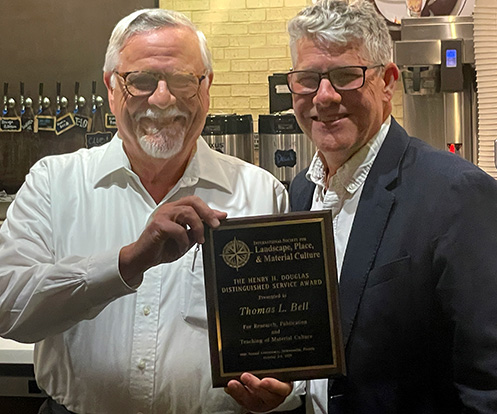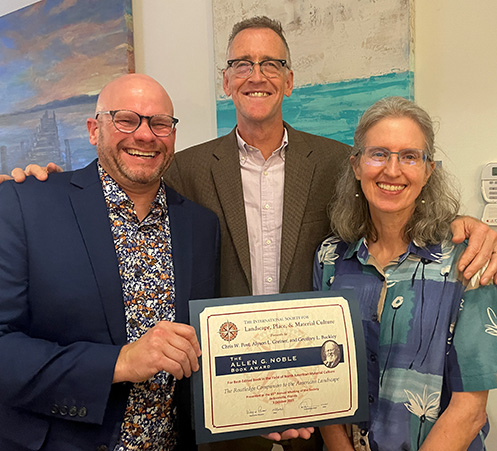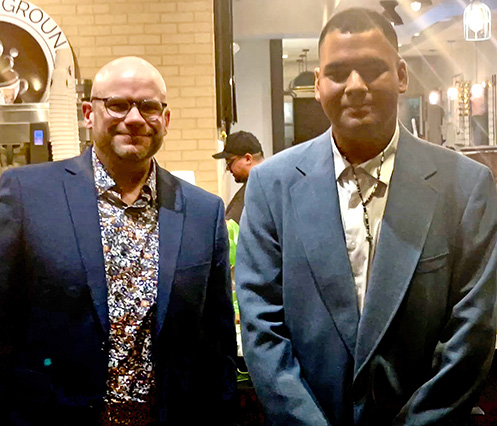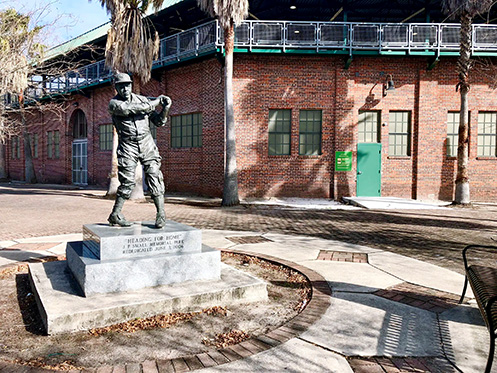Congratulations to this year’s award winners
The International Society for Landscape, Place, & Material Culture is pleased to announce the recipients of its 2025 Awards:
Henry H. Douglas Distinguished Service Award
From the award presentation:
The 2025 recipient of the Henry H. Douglas Award is Thomas L. Bell, retired professor of Geography at the University of Tennessee, in recognition of his outstanding academic contributions in the fields of cultural, urban, and economic geography; for his career-long dedication to excellence in teaching; and for his devoted and enthusiastic service to the Society.

Tom received his B.A. in History (1967), and his M.A. (1969) and Ph.D. degrees (1973) in Geography, from the University of Iowa, a leading Geography doctoral program during the so-called “quantitative revolution” of the early 1970s. After completing his Ph.D., Tom began a distinguished thirty-six-year career at the University of Tennessee, where he was promoted to Associate Professor in 1976 and Professor in 1983. At the University of Tennessee, he taught courses in urban, transportation, economic, and political geography, as well as honors seminars in urban and cultural geography. After his retirement in 2009 he taught courses in urban geography, the geography of North America, and the geography of music as an adjunct professor at Western Kentucky University until 2014. Over the course of his career Tom supervised fifteen master’s theses, sixteen doctoral dissertations, six undergraduate honors theses, and served on dozens of master’s and dissertation committees.
Tom is recognized as one of the discipline’s most respected scholars in the areas of urban economic geography, transportation geography, and cultural geography, and he is considered to be a leading authority on the geography of American popular music. Over the course of his career, he has published nearly 100 articles and book chapters and four books, including the popular introductory human geography textbook, Human Geography: People, Places, and Change and Sound, Society, and the Geography of Popular Music. This research has been supported by grants from a number of prestigious institutions, including the National Science Foundation, the Appalachian Regional Commission, the US Environmental Protection Agency, the National Academy of Sciences, and the US Department of Transportation.
In the area of service, Tom’s contributions are exemplary. At Tennessee, he served twice as associate department head and as the Assistant Dean for Research. He has been highly engaged with the Southeast Division of the American Association of Geographers, serving on a number of committees and as president in 1987-1989. Indeed, in 2016 he received the Lifetime Achievement Award from that organization. He has served on the editorial board of several journals, including Focus on Geography, Journal of Geography, and Southeastern Geographer. And finally, he has been an active member of Pioneer America Society/ISLPMS throughout his career, reviewing numerous manuscripts for Material Culture and serving on the Board of Directors from 2015 to 2017. Given his lifetime of commitment and service to the discipline and his achievements as a scholar and teacher, it is altogether fitting that he should be recognized and honored by this organization.
W. Frank Ainsley Outstanding Service Award
No award presented this year.
Alan G. Noble Book Award
From the award presentation:
First, I would like to thank my fellow members of the Book Awards Committee, Stephanie Roper and Cory Jensen, for spending hours of time this summer reviewing all the book award submissions. I would also like to thank Ellen Hostetter for the time that she spent receiving and logging the submissions, fielding questions and especially in shipping duties to get the books to us for review. I must admit when I received by two boxes of books to review, it seemed overwhelming and a great way to justify not reorganizing my closets this summer.
My work avoidance plans worked quite nicely but as it turned out, the book review process was not an onerous one, and perhaps the greatest benefit was to have the opportunity to review two books which stood out so clearly as the winners in each of the following categories.

The International Society of Landscape, Place and Material Culture seeks to encourage and recognize books by authors regarding material culture in North America. Named for the renowned geographer, Allen G. Noble, the prize in his honor is granted annually for the best-edited book in the field published within two years of the award. So, with that, I am pleased to announce that the winner of the 2025 Allen G. Noble Award for best-edited volume is: The Routledge Companion to the American Landscape (Routledge, 2023), edited by Chris W. Post, Alyson L. Greiner, and Geoffrey L. Buckley.

With its emphasis on landscapes as viewed from a cross-section of disciplines, The Routledge Companion reads like the mission statement for the International Society for Landscape, Place, and Material Culture. Chapter topics are fresh and contemporary and offer the reader a broad spectrum of topics ranging from agriculture to environmental justice, from cultural landscapes to music, sports, and identity. There is even a chapter about “Zombie-infested hellscapes”! If you are attending this conference, then this book has something for you!
This well-edited volume would be a welcome addition to any scholar’s bookshelf and would make an excellent college textbook, sure to draw students in with its contemporary and engaging topics.
We congratulate Chris Post, Alyson Greiner, and Geoffrey Buckley, the 2025 Allen G. Noble Award winners.
Fred B. Kniffen Book Award
From the award presentation:
The Society seeks to encourage and recognize books by authors regarding material culture in North America. Named for the renowned geographer, Fred Kniffen, the prize in his honor is granted annually for the best book in the field published within two years of the award.
I'm very pleased That the International Society for Landscape, Place, & Material Culture (ISLPMC) has selected, Playhouses and Privilege: The Architecture of Elite Childhood, by Abigail Van Slyck (University of Minnesota Press, 2025), to receive the 2025 Fred B. Kniffen Book Award for best book regarding material culture in North America.

After working our way through a giant stack of Kniffen award candidates, it was clear to the committee that one book stood out for its original topic and engaging narrative. Playhouses and Privilege allows the reader to enter the material world created for the children of royals such as Queen Victoria and of royally wealthy Americans, spanning and era from the mid-19th century through to the 1930s.
“Barbie’s Dreamhouse” would look like a shack compared to some backyard “playhouses.” These “playhouses” were built, not just to offer privileged children a place to play, but even more so, to shape their children’s specific social behaviors and class aspirations.
We offer our congratulations to Abigail Van Slyck for her significant contribution to the literature, and for being the recipient of the 2025 Fred B. Kniffen Award.
Warren E. Roberts Graduate Student Paper Award
From the award presentation:
The 2025 recipient of the ISLPMC Warren E. Roberts Award is Seth Kannarr, graduate student in the Department of Geography at the University of Tennessee, Knoxville. The award recognizes excellence in original graduate student fieldwork, documentary research, and writing in the area of traditional North American material culture.

Kannarr’s winning submission is titled “Public Memory in Your Pocket: Analyzing Coins as Everyday Geographies of American Identity.” He explores U.S. coins as “public memory in your pocket,” analyzing their role in shaping everyday geographies and reinforcing American nationalism through the lens of geographic miniaturism. Kannarr utilizes content analysis to examine the iconography, themes, and narratives present across all U.S. coins released in the past fifty years. He identifies three dominant themes which reveal how coins function as vessels of banal nationalism—state support, national resources, and historic value.
Congratulations, Seth.
The Wilhelm-Keiffer Student Research Award
From the award presentation:
Peter Kyriacou of South Florida University won our annual Wilhelm-Keiffer Award for best undergraduate poster presentation at this year’s annual ISLPMC Meeting in Jacksonville, FL. His poster was titled, “Curators and Cemi Idols: The Museum Afterlives of Material Personhood.”

ISLPMC Historic Preservation Award
From the award presentation:
The Durkeeville Historical Society organized in 1998 with the goal of educating others about the rich history of the neighborhood’s African-American community. The neighborhood is named after Union Army officer Joseph H. Durkee and traces its beginning to the Jim Crow Era when racial segregation laws prohibited black residents from living in much of Jacksonville. The people who put down roots in Durkeeville were middle-class doctors, lawyers, educators, and business people, but also ordinary laborers. These residents created a neighborhood that sheltered and nurtured many during a particularly challenging time.
By the 1980s, the community struggled with urban blight, poverty and inner-city crime. A number of the remaining long-term residents formed the Durkeeville Historical Society and collaborated with city officials to revitalize this historic section of Jacksonville. Decaying buildings were replaced, and services and resources were created. One major development for the community was the Durkeeville Historical Museum. The facility contains exhibits and other materials telling the story of Durkeeville, information about African-Americans in Jacksonville and North Florida, and describes the African-American experience in general.
During the past 90 years, Durkeeville has produced many of the city’s prominent African-American residents including local elected officials, labor union leaders, and Civil Rights activists. Also from the neighborhood was Harlem Renaissance composer John Rosamond Johnson, who wrote the music to the song “Lift Ev’ry Voice and Sing,” (his brother James Weldon Johnson wrote the lyrics), and Grammy Award-winning songwriter Charlie “Hoss” Singleton. Other notable residents include the athletes Robert “Bullet Bob” Hayes, who was an Olympic gold medal recipient in the 1964 Tokyo Games and played for the NFL’s Dallas Cowboys; and Artis Gilmore, an NBA Hall-of-Fame player who continues to serve his alma mater Jacksonville University.
 DHS operates the J. P. Small Ballpark and Museum, which interprets the stadium and Negro League Baseball teams that played there during the decades before Jackie Robinson broke the Major League Baseball’s color barrier in 1947.
DHS operates the J. P. Small Ballpark and Museum, which interprets the stadium and Negro League Baseball teams that played there during the decades before Jackie Robinson broke the Major League Baseball’s color barrier in 1947.
Durkeeville Historical Society meets the first Tuesday of every month and holds a fish fry fundraiser on every fourth Saturday. The organization’s museum opened in January 2023 and exhibits artifacts associated with the neighborhood as well as other objects from around Jacksonville. The public is invited to visit every Saturday or by appointment during weekdays. The organization maintains an archive with numerous historic photographs from the community. In cooperation with the city, DHS also operates the J. P. Small Ballpark and Museum, which interprets the stadium and Negro League Baseball teams that played there during the decades before Jackie Robinson broke the Major League Baseball’s color barrier in 1947. In addition to being used by local teams, Major League teams including the Philadelphia Athletics, the New York Giants, and the Brooklyn Dodgers played there during spring training.
Along with many other African-American heritage sites across the United States, the Durkeeville Historical Society and Museum appears on the African-American Heritage Sites mobile app. If you’ve never used it, this app can guide you through more than 2,000 African American places throughout the United States and Territories. The sites can be accessed by four categories: African American Heritage Trails including both driving and walking trails; African American Endangered Historic Places, which helps to raise awareness about the threats facing some of our nation's greatest treasures; African-American Museums, ranging from nationally recognized museums to small local museums; and African-American places that are of national significance and are designated as National Historic Landmarks (NHLs) by the US Secretary of the Interior. All four of these categories are cross-referenced in Sites by State and Territory, and the app also allows you the option to view these sites by an Alphabetical List or by MapBox, like every good app does.
This past March, DHS participated in the city’s 2nd annual Durkeeville Revitalization Study Community Workshop. These workshops are intended to create an equitable and inclusive implementation strategy through community engagement and consensus building, focusing on neighborhood commercial corridors, housing opportunities, recreational spaces, and supportive services for residents and other stakeholders. Lastly, DHS partners with other heritage groups such as the Jacksonville History Center, and helped spread attention about that organization’s Lunch and Learn Program as part of the annual observance of Historic Preservation Month last May.
For these reasons, the ISLPMC historic preservation awards committee is very proud to recognize the Durkeeville Historical Society tonight for its outstanding contributions to the recognition and preservation of Jacksonville’s heritage and material culture. To receive the ISLPMC Historic Preservation Award tonight are DHS President Lloyd Washington and Ms. Barbara Richardson, the organization’s Financial Secretary.
ISLPMC Historic Preservation Certificate of Merit
From the award presentation:
For the ISLPMC Citation of Merit tonight we recognize the Lyndeborough Heritage Commission. While historic preservation commissions are commonly found in many American cities, they are exceedingly rare in our nation’s small towns.For ISLPMC’s Citation of Merit tonight we recognize Old Arlington, Inc., which has been integral to the preservation and interpretation of the Arlington area of Jacksonville. Formed in 1993 to document and preserve Arlington’s rich history, the organization partnered with the City of Jacksonville in commissioning the first survey of its historic buildings and published the companion book, Arlington, A New History.
Since its founding, Old Arlington, Inc., or as it is known “OAI,” has been instrumental in documenting Arlington’s rich and interesting history and in preserving its historic structures, including Norman Studios Silent Film Museum. The organization is focused on preserving and celebrating Arlington’s significant concentration of Mid-Century Modern architecture. The boundaries of Arlington are the St. Johns River on the North to the Atlantic Blvd corridor on the South and the St. Johns River on the west to Mill Creek- Hartsfield Road on the east.
 Old Arlington, Inc., or as it is known “OAI,” has been instrumental in documenting Arlington’s rich and interesting history and in preserving its historic structures, including Norman Studios Silent Film Museum.
Old Arlington, Inc., or as it is known “OAI,” has been instrumental in documenting Arlington’s rich and interesting history and in preserving its historic structures, including Norman Studios Silent Film Museum.
Following the opening of the Mathews Bridge in 1953, the Arlington area experienced an exciting 30-year development boom. OAI recognizes that preserving this architecture is a vital component in revitalizing Arlington.
In addition to historic preservation, OAI is committed to:
- Economic development;
- Neighborhood revitalization;
- Advocating for community needs;
- Supporting Arlington business and organizations; and
- Hosting community events that showcase our neighborhoods.
The City of Jacksonville, as part of its Renew Arlington initiative, has created a Community Redevelopment Area and Redevelopment Plan for three major commercial corridors within the Arlington community: University Boulevard, and Merrill and Arlington Roads. The plan is intended to serve as a framework for guiding development and redevelopment of the Renew Arlington Community Redevelopment Area. The result of a decade of community efforts to revitalize Arlington, the resulting Renew Arlington plan considered the findings of other redevelopment studies for the area. OAI has been an integral part of this initiative and is represented on the Renew Arlington Advisory Committee.
With the stated goal of creating Jacksonville’s Next Great Historic Neighborhood, the organization holds regular meetings and invites interesting speakers to present of various topics.
Much of OAI’s financial support is through membership. Another fundraiser is its annual Arlington Mod & More Home Tour. This past May, the organization held its inaugural Arlington Gardens Tour & Symposium. The garden tour included several residential gardens in Arlington, the Tree Hill Nature Park, and the Jacksonville Arboretum. The associated symposium, which was held here at Jacksonville University, hosted Gary Alan, a longtime Arlington resident, landscape designer, and creator of the website, “The Designer's Landscape.” Gary has been featured on HGTV and on PBS.
OAI worked with Comcast to develop a series of 23 historical markers that tell the stories of Arlington residents from the early 1800s up until the present are located throughout the area. The organization also publishes a newsletter several times a year. Lastly, OAI encourages Arlington residents to get involved in sponsoring neighborhood cleanup events, reporting blight, and participating in neighborhood watch programs.
With all of this in mind, the ISLPMC historic preservation awards committee would very much like to recognize Old Arlington, Inc. for its outstanding efforts to preserve the heritage and material culture of Jacksonville. Unfortunately, no one from Old Arlington could be here to receive the ISLPMC Citation of Merit tonight so we’re presenting it to the group in absentia.
